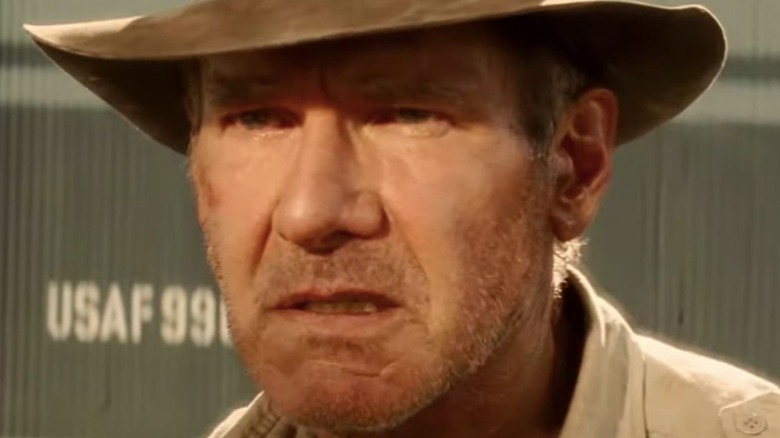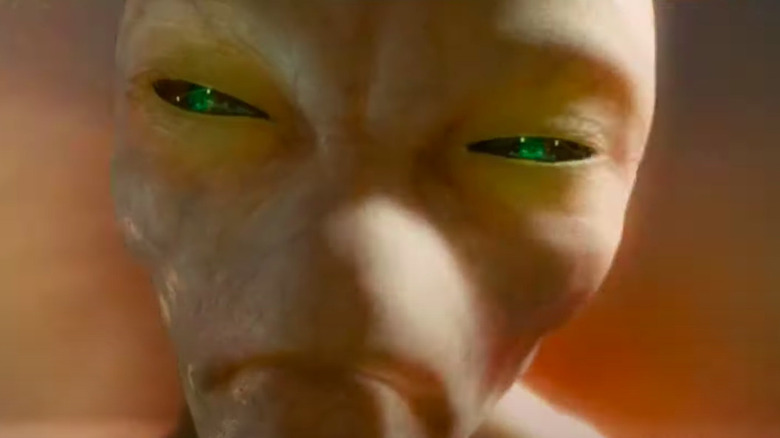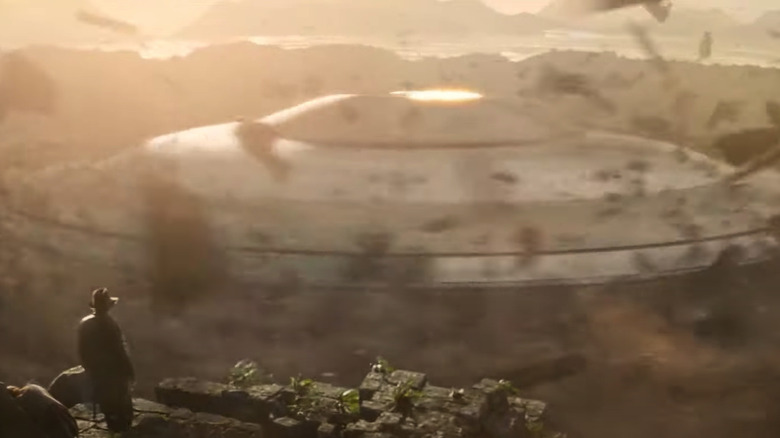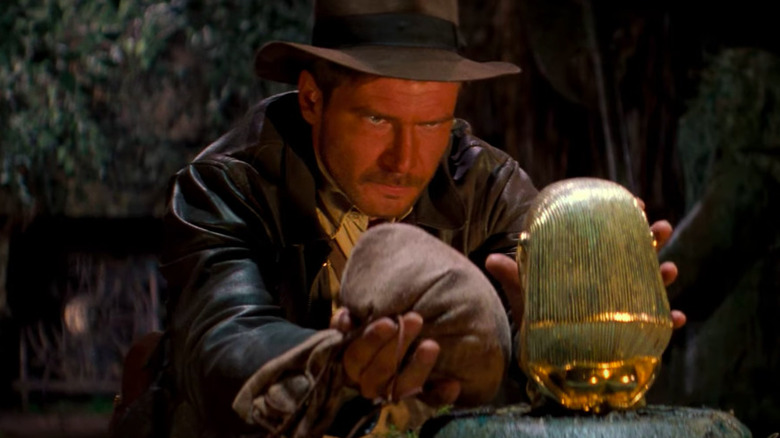The Absurd Indiana Jones 4 Plotline The Screenwriter Wanted To Change
In the history of Hollywood, few big-budget blockbuster sequels have ever been quite as highly-anticipated as "Indiana Jones and the Kingdom of the Crystal Skull." The fourth installment in Steven Spielberg's iconic series and the first entry in the franchise since the 1980s, the film saw an older and more grizzled Indy (Harrison Ford) go head-to-head against the Soviets in a race to find a legendary crystal skull, which seems to hold bizarre telepathic powers and mysterious extraterrestrial origins. The film saw the return of Ford, as well as Karen Allen as Marion Ravenwood, and introduced a host of new characters and concepts to the beloved films series.
Debuting in cinemas in 2008, the film was a major box office success, grossing over $790 million at the worldwide box office (via Box Office Mojo). Despite the film's financial success, it arguably proved polarizing among audiences at the time of its release for many reasons -– ranging from the film's reliance on CGI to the introduction of characters such as Mutt Williams (Shia LeBeouf). Now, with over a decade of hindsight on the movie's release, it seems that even insiders close to the movie had their own reservations about the overall direction of the movie. In fact, screenwriter David Koepp (who penned "Crystal Skull," as well as movies such as "Mission: Impossible" and "Jurassic Park") has opened up about one specific and controversial plot element of the movie that he tried to change during the development of the project.
David Koepp fought to prevent aliens from being in Indiana Jones 4
As most fans of the franchise likely now know, the climax of "Indiana Jones and the Kingdom of the Crystal Skull" confirms that the titular skulls of the film are not biblical or magic in nature, as previous films in the franchise had explored. Instead, they are the skulls of interdimensional aliens who depart earth once the skulls are returned to their skeletons.
During a recent interview on the Script Apart podcast (via Comic Book), David Koepp opened up about his involvement in the development of "Indiana Jones and the Kingdom of the Crystal Skull." Addressing the switch to extraterrestrial life as the central McGuffin of the movie, Koepp admitted that he was "never happy with the idea [of 'aliens']" as the core plot of the film.
In fact, Koepp admitted that he fought to try and get the story to go in a different direction. Noting his concern about including aliens in the movie, Koepp said, "When I came on, I tried to convince [Steven Spielberg and George Lucas] to change it — I had this other idea. They didn't want to change it. I'm not saying mine would've been better. But I think that a lot of the pushback that movie got, in a larger sense aside from little things people might not have liked — that were too silly or whatever — the larger one was that [fans said], 'We don't feel like aliens should've been in an Indiana Jones movie.'"
The idea was to make Indiana Jones 4 an homage to 1950s B-movies
The notion of introducing aliens into the world of "Indiana Jones" may seem like a significant shift for many fans, but the decision was still essentially rooted in the origins of the franchise. "Indiana Jones" has always been a throwback to a bygone era of Hollywood cinema, and "Crystal Skull" is no different – it just marks a shift in the inspiration for the throwback.
Nowhere is that clearer than in the homage "Crystal Skull" pays to the pop culture of the 1950s. In fact, upon the film's release, George Lucas addressed this, telling Entertainment Weekly, "The idea was to take the genre of Saturday-matinee serials, which were popular in the '30s and '40s, and say, "What kind of B movie was popular in the '50s, like those B movie serials were popular in the '40s?" And use that as the overall uber-genre. We wouldn't do it as a Saturday-matinee serial. We'd do it as a B movie from the '50s."
With that shift to the 1950s came the introduction of elements that defined those B movies. Gone were the Nazi battles and horseback chases of the 1930s serials, and instead, Spielberg and Lucas chose to focus on sci-fi elements of the atomic age. From this shift came the natural inclusion of extraterrestrial life into the world of "Indiana Jones."
Several Indiana Jones story ideas were pitched, but never made
While some felt that the inclusion of aliens was a step in the wrong direction for the "Indiana Jones" franchise, it's worth noting that the franchise has remained relatively flexible over the years in terms of its plotting and story ideas. "Raiders of the Lost Ark" and "The Last Crusade" both see Indy battle Nazis while in search of lost biblical artifacts, and "Temple of Doom" completely side-stepped anything related to Nazis or Old Testament-era artifacts in favor of a mystical journey in India to rescue lost children. Few plot threats connect any of the franchise's adventures, allowing for a great degree of flexibility in the stories Spielberg could tell.
This idea of narrative flexibility is even more clear when examining the "Indiana Jones" movies that were planned, but never got made. Several story ideas were batted around for additional "Indy" movies over the years before the concept of aliens ever even entered the picture. Some of these ideas involved Indy adventuring through a haunted house, while another would have seen Jones discovering living dinosaurs. Eventually, in the 1990s, a script for a possible fourth movie was written called "Indiana Jones and the Saucermen From Mars." This script introduced the concept of aliens into the franchise, and many of its narrative elements would eventually find their way into "Indiana Jones and the Kingdom of the Crystal Skull."



